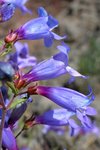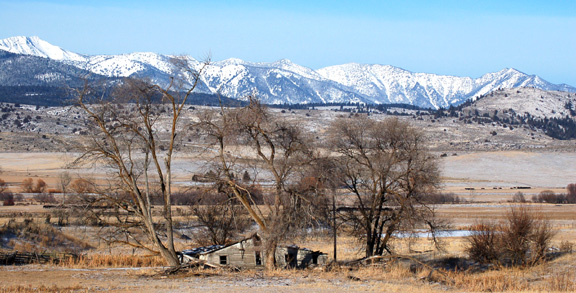Monday, March 8, 2010
Western Watersheds Challenges the Legal & Political Purgatory for Sage Grouse.
Yesterday's post on the sage grouse (AKA greater sage-grouse or greater sage grouse), Centrocercus urophasianus, noted “ 'warranted but precluded' is sort of the endangered species Newspeak equivalent of an old folks nursing home or hospice, where endangered species lie around without care in a sort of political "purgatory." As the grouse and the many other species receiving that designation are accepted to be "endangered" or "threatened" by the "warranted" portion of the phrase, it is the "precluded" portion that creates the "catch-22" which actually places a species in legal and political purgatory. Today, Western Watersheds Project and Advocates For The West filed a court complaint in Idaho challenging the the US Fish & Wildlife Service's rational and legal basis for precluding the sage grouse, whose endangerment is now legally acknowledged, from being listed as such, and from being legally safeguarded under the protections offered by the Endangered Species Act. In their complaint they describe the legal and political purgatory: "This “precluded” determination relegates the sage-grouse to the long list of ESA “candidate” species – a black hole from which few species ever emerge, and under which they receive no ESA protection – and represents yet another non-scientific, politicized, and arbitrary determination that prevents the sage-grouse from obtaining the ESA protection that it urgently needs." (See larger portion of Complaint below)
WWP press Release:
Box 1770
Hailey, ID 83333
tel: (208) 788-2290
fax: (208) 788-2298
email: wwp@westernwatersheds.org
web site: www.westernwatersheds.org
Working to protect and restore Western Watersheds and Wildlife
Western Watersheds Project Files Legal Challenge To Denial of Endangered Species Act Protections for Greater Sage-Grouse
For immediate release - March 8, 2010
Contacts:
Jon Marvel, Executive Director Western Watersheds Project: 208-788-2290 ext. 11,
Laird Lucas, Executive Director, Advocates For The West: 208-342-7024 ext. 201
In response to the announcement on Friday March 5 by Secretary of the Interior Ken Salazar that the listing of greater sage-grouse and two of its distinct population segments (Mono Basin and Eastern Washington) under the protections of the Endangered Species Act is “warranted but precluded”, Western Watersheds Project has filed litigation in federal District Court in Boise, Idaho challenging the “precluded” portion of the finding.
The litigation charges that the U.S. Fish and Wildlife Service and the Department of the Interior violated the Administrative Procedure Act and the Endangered Species Act by finding that the listing of greater sage-grouse is “precluded”.
“The Obama administration rightfully concluded that the greater sage-grouse fully qualify for the protections of the Endangered Species Act,” said Jon Marvel, executive director of Western Watersheds Project. “Unfortunately, the administration has violated the law in not listing sage-grouse at the same time.”
The greater sage-grouse is a charismatic bird that lives in sagebrush steppe in eleven western states. First described by Lewis and Clark in 1805, nineteenth century travelers and settlers reported seeing huge flocks of sage-grouse that darkened the sky as they lifted from valley floors. However, westward expansion and development over the next 200 years has eliminated almost half of sagebrush habitat. The total sage-grouse population, estimated between 140,000-500,000 birds, has declined between 69-99 percent from historic levels.
Myriad human activities in the Sagebrush Sea have decimated sage-grouse habitat, including livestock grazing, oil and gas development, agricultural conversion, application of herbicides and pesticides, unnatural fire, urban sprawl, mining, off-road vehicle use, and the placement and construction of utility corridors, roads and fences.
The Fish and Wildlife Service’s finding indicates that current conservation efforts are failing to conserve sage-grouse.
“The ever growing effects of development of the sagebrush sea will doom sage-grouse without the mandatory protection provided by listing the species under the protections of the Endangered Species Act.” said Laird Lucas, executive director of Advocates For The West, the Boise-based legal advocacy firm representing Western Watersheds Project in the sage-grouse
litigation.
__
Here is the introduction to the Complaint:
Todd C. Tucci (ISB # 6526)
ADVOCATES FOR THE WEST
P.O. Box 1612
Boise, ID 83701
(208) 342-7024
(208) 342-8286 (fax)
ttucci@advocateswest.org
Laurence (“Laird”) J. Lucas (ISB # 4733)
P.O. Box 1342
Boise, Idaho 83701
(208) 424-1466 (phone and fax)
llucas@lairdlucas.org
Attorneys for Plaintiff Western Watersheds Project
UNITED STATES DISTRICT COURT
FOR THE DISTRICT OF IDAHO
WESTERN WATERSHEDS PROJECT,
Plaintiff,
vs.
U.S. FISH AND WILDLIFE SERVICE,
Defendant.
No. 06-cv-277-BLW
FIRST SUPPLEMENTAL
COMPLAINT
INTRODUCTION
1. In December 2007, the Court ruled in this case that Defendant U.S. Fish and Wildlife Service acted unlawfully in determining that Endangered Species Act listing of the greater sage-grouse was “not warranted,” due to improper political interference in the listing process and the Service’s arbitrary treatment of the best available science showing that sage grouse populations and habitats are deeply imperiled. See Docket No. 118. The Court remanded for the Service to make a new Endangered Species Act listing determination; and approved remand stipulations in which Plaintiff Western Watersheds Project agreed that the Service could delay the listing decision to take into account the latest sage-grouse science, as reported in a Studies for Avian Biology “Monograph” being prepared by leading sage-grouse researchers. See Docket Nos. 130, 137 & 183.
2. Based on that Monograph and other best available science, the Service announced on March 5, 2010 its new finding that ESA listing of greater sage-grouse is “warranted” under the ESA, because of the many threats facing sage-grouse populations and their sagebrush habitats – particularly habitat fragmentation from energy development, livestock grazing, infrastructure, fires, weed invasions, and climate change impacts. See U.S. Fish and Wildlife Service, “Endangered and Threatened Wildlife and Plants: 12-Month Findings for Petitions to List the Greater Sage-Grouse (Centrocercus urophasianus) As Threatened or Endangered,” available at http://www.fws.gov/mountain-prairie/species/birds/sagegrouse/FR03052010.pdf (hereafter, “March 2010 Finding”).
3. Yet despite these scientific findings acknowledging that the sage-grouse qualifies for listing as an endangered or threatened species, the Service is perpetuating its unlawful refusal to protect sage-grouse under the ESA. In the March 2010 Finding, the Service determined not to proceed with a proposed listing rule for the greater sage-grouse, asserting that its own
bureaucratic backlog and lack of resources supposedly preclude it from moving forward with an ESA listing rule for the sage-grouse this year.
4. This “precluded” determination relegates the sage-grouse to the long list of ESA “candidate” species – a black hole from which few species ever emerge, and under which they receive no ESA protection – and represents yet another non-scientific, politicized, and arbitrary determination that prevents the sage-grouse from obtaining the ESA protection that it urgently
needs.
4. [sic] As alleged below, the Court must reject the Service’s “precluded” finding as being arbitrary, capricious, and contrary to law. The Service cannot justify its refusal to proceed with a sage-grouse listing based on its own bureaucratic listing backlog and other grounds cited in the March 2010 Finding – particularly when the Service has already invested the bulk of the resources needed for a sage-grouse listing in rendering the March 2010 Finding; and when the Service has already been found by this Court (and many others) to have repeatedly violated the ESA in not proceeding to list sage-grouse and other species as directed by Congress. Moreover, the Service has abjectly failed to make expeditious progress in addressing the large backlog of species that warrant ESA protection; and it is relying on improper budgetary and other excuses to avoid proceeding with the greater sage-grouse listing, contrary to the ESA’s statutory requirements and without rational justification.
5. Plaintiff Western Watersheds Project thus brings this First Supplemental Complaint to challenge the “precluded” part of the Service’s March 1010 Finding that ESA listing of greater sage-grouse is “warranted, but precluded,” as being arbitrary, capricious, and contrary to law. WWP asks the Court to quickly review and reverse that “precluded” determination, and remand with instructions for the Service to promptly publish a proposed listing rule within a set deadline, so that greater sage-grouse can finally receive the ESA protections that science – and the Service’s own “warranted” determination – show are necessary
to prevent this icon of the sagebrush sea from declining further toward extinction.
____________________
Good AP Article:
Group challenges sage grouse finding
By MEAD GRUVER Associated Press Writer
Posted: 03/08/2010 03:07:51 PM PST
Updated: 03/08/2010 05:43:58 PM PST
CHEYENNE, Wyo.—An environmental group is challenging plans by the Interior Department to classify sage grouse as merely a candidate for protection under the Endangered Species Act and not list the bird as threatened or endangered.
The department announced Friday that federal protection as an endangered or threatened species is warranted but precluded by higher priorities—species deemed in more dire need of protection right now.
Western Watersheds questioned that finding in a supplemental complaint filed Monday in U.S. District Court in Boise, Idaho.
"The sage grouse is, in our judgment, as qualified as any species on the candidate list for the protections of the act," Jon Marvel, director of Western Watersheds, said Monday. "Of course they should be acting on all of these species, and why
aren't they?"
The new complaint calls the candidate species list "a black hole from which few species ever emerge, and under which they receive no ESA protection." The decision to put the sage grouse on the list was "arbitrary, capricious and contrary to law," the
group claims.
An Interior spokeswoman declined to comment because the matter is being litigated.
Western Watersheds sued in 2006 over a previous decision not to list sage grouse. U.S. District Judge B. Lynn Winmill found that the earlier decision was politically motivated and told the department to reevaluate, leading to Friday's announcement.
A supplemental complaint is filed to bring forth facts and claims that happen after an initial complaint in a case, said Laird Lucas, a Western Watersheds attorney.
The notion that sage grouse aren't a high priority for protection is implausible after the government spent considerable time and money studying whether they deserved protection, Lucas said
"They can't now claim they don't have the money to
move forward. It does not make sense," Lucas said.
"And that, to me, says really it is a political determination at the end." . . . .
To read entire article, See:
http://www.mercurynews.com/breaking-news/ci_14635602?nclick_check=1
___________________
SEE ALSO:
F&WS Notice of 12–month petition findings
SUNDAY, MARCH 7, 2010
Hells Canyon Springing & Purgatory for Sage Grouse
and,
THURSDAY, FEBRUARY 11, 2010
Environmental issues: Sage Grouse; Grazing Fee
WWP press Release:
Box 1770
Hailey, ID 83333
tel: (208) 788-2290
fax: (208) 788-2298
email: wwp@westernwatersheds.org
web site: www.westernwatersheds.org
Working to protect and restore Western Watersheds and Wildlife
Western Watersheds Project Files Legal Challenge To Denial of Endangered Species Act Protections for Greater Sage-Grouse
For immediate release - March 8, 2010
Contacts:
Jon Marvel, Executive Director Western Watersheds Project: 208-788-2290 ext. 11,
Laird Lucas, Executive Director, Advocates For The West: 208-342-7024 ext. 201
In response to the announcement on Friday March 5 by Secretary of the Interior Ken Salazar that the listing of greater sage-grouse and two of its distinct population segments (Mono Basin and Eastern Washington) under the protections of the Endangered Species Act is “warranted but precluded”, Western Watersheds Project has filed litigation in federal District Court in Boise, Idaho challenging the “precluded” portion of the finding.
The litigation charges that the U.S. Fish and Wildlife Service and the Department of the Interior violated the Administrative Procedure Act and the Endangered Species Act by finding that the listing of greater sage-grouse is “precluded”.
“The Obama administration rightfully concluded that the greater sage-grouse fully qualify for the protections of the Endangered Species Act,” said Jon Marvel, executive director of Western Watersheds Project. “Unfortunately, the administration has violated the law in not listing sage-grouse at the same time.”
The greater sage-grouse is a charismatic bird that lives in sagebrush steppe in eleven western states. First described by Lewis and Clark in 1805, nineteenth century travelers and settlers reported seeing huge flocks of sage-grouse that darkened the sky as they lifted from valley floors. However, westward expansion and development over the next 200 years has eliminated almost half of sagebrush habitat. The total sage-grouse population, estimated between 140,000-500,000 birds, has declined between 69-99 percent from historic levels.
Myriad human activities in the Sagebrush Sea have decimated sage-grouse habitat, including livestock grazing, oil and gas development, agricultural conversion, application of herbicides and pesticides, unnatural fire, urban sprawl, mining, off-road vehicle use, and the placement and construction of utility corridors, roads and fences.
The Fish and Wildlife Service’s finding indicates that current conservation efforts are failing to conserve sage-grouse.
“The ever growing effects of development of the sagebrush sea will doom sage-grouse without the mandatory protection provided by listing the species under the protections of the Endangered Species Act.” said Laird Lucas, executive director of Advocates For The West, the Boise-based legal advocacy firm representing Western Watersheds Project in the sage-grouse
litigation.
__
Here is the introduction to the Complaint:
Todd C. Tucci (ISB # 6526)
ADVOCATES FOR THE WEST
P.O. Box 1612
Boise, ID 83701
(208) 342-7024
(208) 342-8286 (fax)
ttucci@advocateswest.org
Laurence (“Laird”) J. Lucas (ISB # 4733)
P.O. Box 1342
Boise, Idaho 83701
(208) 424-1466 (phone and fax)
llucas@lairdlucas.org
Attorneys for Plaintiff Western Watersheds Project
UNITED STATES DISTRICT COURT
FOR THE DISTRICT OF IDAHO
WESTERN WATERSHEDS PROJECT,
Plaintiff,
vs.
U.S. FISH AND WILDLIFE SERVICE,
Defendant.
No. 06-cv-277-BLW
FIRST SUPPLEMENTAL
COMPLAINT
INTRODUCTION
1. In December 2007, the Court ruled in this case that Defendant U.S. Fish and Wildlife Service acted unlawfully in determining that Endangered Species Act listing of the greater sage-grouse was “not warranted,” due to improper political interference in the listing process and the Service’s arbitrary treatment of the best available science showing that sage grouse populations and habitats are deeply imperiled. See Docket No. 118. The Court remanded for the Service to make a new Endangered Species Act listing determination; and approved remand stipulations in which Plaintiff Western Watersheds Project agreed that the Service could delay the listing decision to take into account the latest sage-grouse science, as reported in a Studies for Avian Biology “Monograph” being prepared by leading sage-grouse researchers. See Docket Nos. 130, 137 & 183.
2. Based on that Monograph and other best available science, the Service announced on March 5, 2010 its new finding that ESA listing of greater sage-grouse is “warranted” under the ESA, because of the many threats facing sage-grouse populations and their sagebrush habitats – particularly habitat fragmentation from energy development, livestock grazing, infrastructure, fires, weed invasions, and climate change impacts. See U.S. Fish and Wildlife Service, “Endangered and Threatened Wildlife and Plants: 12-Month Findings for Petitions to List the Greater Sage-Grouse (Centrocercus urophasianus) As Threatened or Endangered,” available at http://www.fws.gov/mountain-prairie/species/birds/sagegrouse/FR03052010.pdf (hereafter, “March 2010 Finding”).
3. Yet despite these scientific findings acknowledging that the sage-grouse qualifies for listing as an endangered or threatened species, the Service is perpetuating its unlawful refusal to protect sage-grouse under the ESA. In the March 2010 Finding, the Service determined not to proceed with a proposed listing rule for the greater sage-grouse, asserting that its own
bureaucratic backlog and lack of resources supposedly preclude it from moving forward with an ESA listing rule for the sage-grouse this year.
4. This “precluded” determination relegates the sage-grouse to the long list of ESA “candidate” species – a black hole from which few species ever emerge, and under which they receive no ESA protection – and represents yet another non-scientific, politicized, and arbitrary determination that prevents the sage-grouse from obtaining the ESA protection that it urgently
needs.
4. [sic] As alleged below, the Court must reject the Service’s “precluded” finding as being arbitrary, capricious, and contrary to law. The Service cannot justify its refusal to proceed with a sage-grouse listing based on its own bureaucratic listing backlog and other grounds cited in the March 2010 Finding – particularly when the Service has already invested the bulk of the resources needed for a sage-grouse listing in rendering the March 2010 Finding; and when the Service has already been found by this Court (and many others) to have repeatedly violated the ESA in not proceeding to list sage-grouse and other species as directed by Congress. Moreover, the Service has abjectly failed to make expeditious progress in addressing the large backlog of species that warrant ESA protection; and it is relying on improper budgetary and other excuses to avoid proceeding with the greater sage-grouse listing, contrary to the ESA’s statutory requirements and without rational justification.
5. Plaintiff Western Watersheds Project thus brings this First Supplemental Complaint to challenge the “precluded” part of the Service’s March 1010 Finding that ESA listing of greater sage-grouse is “warranted, but precluded,” as being arbitrary, capricious, and contrary to law. WWP asks the Court to quickly review and reverse that “precluded” determination, and remand with instructions for the Service to promptly publish a proposed listing rule within a set deadline, so that greater sage-grouse can finally receive the ESA protections that science – and the Service’s own “warranted” determination – show are necessary
to prevent this icon of the sagebrush sea from declining further toward extinction.
____________________
Good AP Article:
Group challenges sage grouse finding
By MEAD GRUVER Associated Press Writer
Posted: 03/08/2010 03:07:51 PM PST
Updated: 03/08/2010 05:43:58 PM PST
CHEYENNE, Wyo.—An environmental group is challenging plans by the Interior Department to classify sage grouse as merely a candidate for protection under the Endangered Species Act and not list the bird as threatened or endangered.
The department announced Friday that federal protection as an endangered or threatened species is warranted but precluded by higher priorities—species deemed in more dire need of protection right now.
Western Watersheds questioned that finding in a supplemental complaint filed Monday in U.S. District Court in Boise, Idaho.
"The sage grouse is, in our judgment, as qualified as any species on the candidate list for the protections of the act," Jon Marvel, director of Western Watersheds, said Monday. "Of course they should be acting on all of these species, and why
aren't they?"
The new complaint calls the candidate species list "a black hole from which few species ever emerge, and under which they receive no ESA protection." The decision to put the sage grouse on the list was "arbitrary, capricious and contrary to law," the
group claims.
An Interior spokeswoman declined to comment because the matter is being litigated.
Western Watersheds sued in 2006 over a previous decision not to list sage grouse. U.S. District Judge B. Lynn Winmill found that the earlier decision was politically motivated and told the department to reevaluate, leading to Friday's announcement.
A supplemental complaint is filed to bring forth facts and claims that happen after an initial complaint in a case, said Laird Lucas, a Western Watersheds attorney.
The notion that sage grouse aren't a high priority for protection is implausible after the government spent considerable time and money studying whether they deserved protection, Lucas said
"They can't now claim they don't have the money to
move forward. It does not make sense," Lucas said.
"And that, to me, says really it is a political determination at the end." . . . .
To read entire article, See:
http://www.mercurynews.com/breaking-news/ci_14635602?nclick_check=1
___________________
SEE ALSO:
F&WS Notice of 12–month petition findings
SUNDAY, MARCH 7, 2010
Hells Canyon Springing & Purgatory for Sage Grouse
and,
THURSDAY, FEBRUARY 11, 2010
Environmental issues: Sage Grouse; Grazing Fee











